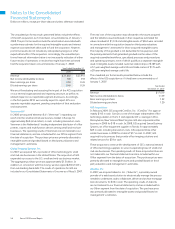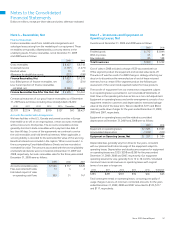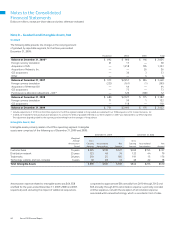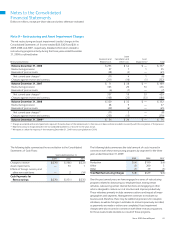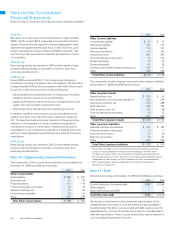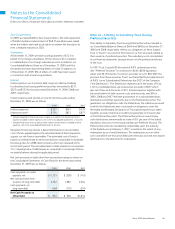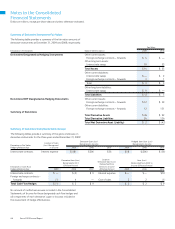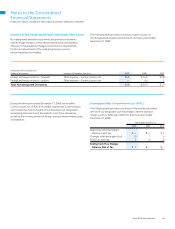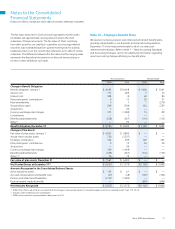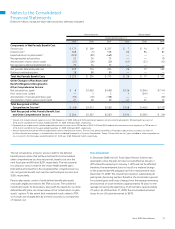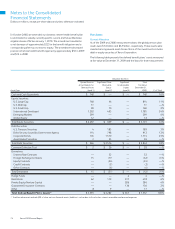Xerox 2009 Annual Report Download - page 68
Download and view the complete annual report
Please find page 68 of the 2009 Xerox annual report below. You can navigate through the pages in the report by either clicking on the pages listed below, or by using the keyword search tool below to find specific information within the annual report.
66 Xerox 2009 Annual Report
Notes to the Consolidated
Financial Statements
Dollars in millions, except per-share data and unless otherwise indicated.
By their nature, all derivative instruments involve, to varying degrees,
elements of market and credit risk. The market risk associated with
these instruments resulting from currency exchange and interest rate
movements is expected to offset the market risk of the underlying
transactions, assets and liabilities being hedged. We do not believe
there is significant risk of loss in the event of non-performance by
the counterparties associated with these instruments because these
transactions are executed with a diversified group of major financial
institutions. Further, our policy is to deal with counterparties having a
minimum investment grade or better credit rating. Credit risk is managed
through the continuous monitoring of exposures to such counterparties.
Interest Rate Risk Management
We use interest rate swap agreements to manage our interest rate
exposure and to achieve a desired proportion of variable and fixed
rate debt. These derivatives may be designated as fair value hedges or
cash flow hedges depending on the nature of the risk being hedged.
Fair Value Hedges
For derivative instruments that are designated and qualify as a fair value
hedge, the gain or loss on the derivative, as well as the offsetting loss or
gain on the hedged item attributable to the hedged risk, are recognized
in current earnings. As of December 31, 2009 and 2008, pay variable/
receive fixed interest rate swaps with notional amounts of $2,350
and $675 with a net asset fair value of $1 and $53, respectively, were
designated and accounted for as fair value hedges. The swaps were
structured to hedge the fair value of related debt by converting them
from fixed rate instruments to variable rate instruments. No ineffective
portion was recorded to earnings during 2009, 2008 or 2007.
The following is a summary of our fair value hedges at December
31, 2009:
Note 13 – Financial Instruments
We are exposed to market risk from changes in foreign currency
exchange rates and interest rates, which could affect operating results,
financial position and cash flows. We manage our exposure to these
market risks through our regular operating and financing activities and,
when appropriate, through the use of derivative financial instruments.
These derivative financial instruments are utilized to hedge economic
exposures, as well as to reduce earnings and cash flow volatility resulting
from shifts in market rates. We enter into limited types of derivative
contracts, including interest rate swap agreements, foreign currency spot,
forward and swap contracts and net purchased foreign currency options
to manage interest rate and foreign currency exposures. Our primary
foreign currency market exposures include the Japanese Yen, Euro
and British Pound Sterling. The fair market values of all our derivative
contracts change with fluctuations in interest rates and/or currency
rates and are designed so that any changes in their values are offset by
changes in the values of the underlying exposures. Derivative financial
instruments are held solely as risk management tools and not for trading
or speculative purposes.
We are required to recognize all derivative instruments as either assets
or liabilities at fair value in the balance sheet. As permitted, certain of
these derivative contracts have been designated for hedge accounting
treatment. Certain of our derivatives that do not qualify for hedge
accounting are effective as economic hedges. These derivative contracts
are likewise required to be recognized each period at fair value and
therefore do result in some level of volatility. The level of volatility will
vary with the type and amount of derivative hedges outstanding, as
well as fluctuations in the currency and interest rate market during the
period. The related cash flow impacts of all of our derivative activities
are reflected as cash flows from operating activities.
Weighted
Year First Net Average
Designated as Notional Fair Interest Interest
Debt Instrument Hedge Amount Value Rate Paid Rate Received Basis Maturity
Senior Notes due 2012 2009 $ 1,100 $ (2) 4.05% 5.50% Libor 2012
Senior Notes due 2013 2009 400 — 3.92% 5.65% Libor 2013
Senior Notes due 2014 2009 750 3 5.51% 8.25% Libor 2014
Senior Notes due 2016 2009 100 — 3.11% 6.40% Libor 2016
Total Fair Value Hedges $ 2,350 $ 1


